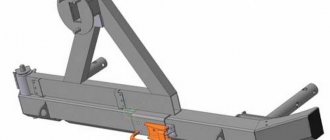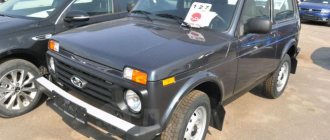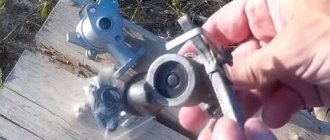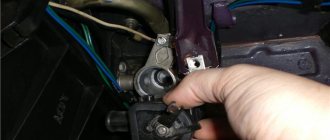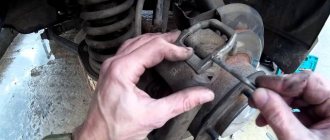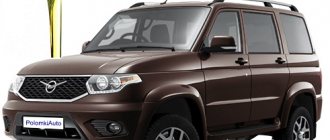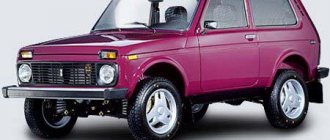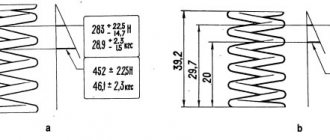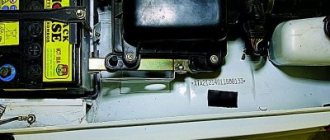VAZ 21213 | Refill tanks
2.3.3. Refill tanks
| GENERAL INFORMATION |
| Year | Model | Series name | Cylinder displacement (cm3) | Oil volume in 5-gearbox transmission | Engine oil volume (including filter) |
| 1984–1986 | troper/ bighorn | 4zd1 | 2250 | 4,6 | 4,4 |
| 1984–1986 | troper/ bighorn | S223 T | 2238 | 4,6 | 6,0 |
| 1987 | troper/ bighorn | 4ze1 | 2559 | 3,1 | 4,4 |
| 1987 | troper/ bighorn | S223 T | 2238 | 4,6 | 6,0 |
| 1987 | troper/ bighorn | 4jb1-T | 2772 | – | – |
| 1988 | troper/ bighorn | 4ze1 | 2559 | 3,1 | 4,4 |
| 1988 | troper/ bighorn | 4jb1-T | 2772 | – | – |
| 1989 | troper/ bighorn | 4ze1 | 2559 | 3,1 | 5,2 |
| 1989 | troper/ bighorn | v6, 2.8 l | 2800 | 3,1 | 4,5 |
| 1989 | amigo/ mu | 4zd1 | 2250 | 1,6 | 4,2 |
| 1989 | amigo/ mu | 4ze1 | 2559 | 3,1 | 5,2 |
| 1990 | troper/ bighorn | 4ze1 | 2559 | 3,1 | 5,2 |
| 1991 | troper/ bighorn | v6, 2.8 l | 2800 | 3,1 | 4,5 |
| 1991 | amigo/ mu | 4zd1 | 2250 | 1,6 | 4,2 |
| 1991 | amigo/ mu | 4ze1 | 2559 | 3,1 | 5,2 |
| 1991 | rodeo | 4ze1 | 2559 | 3,1 | 5,8 |
| 1991 | rodeo | v6 | 3100 | 2,4 | 4,3 |
| 1992 | amigo/ mu | 4zd1 | 2250 | 1,6 | 4,2 |
| 1992 | amigo/ mu | 4ze1 | 2559 | 3,1 | 5,2 |
| 1992 | rodeo | 4ze1 | 2559 | 3,1 | 5,8 |
| 1992 | rodeo | v6 | 3100 | 2,4 | 4,3 |
| 1993 | amigo/ mu | 4zd1 | 2250 | 1,6 | 4,2 |
| 1993 | amigo/ mu | 4ze1 | 2559 | 3,1 | 5,2 |
| 1993 | rodeo | 4ze1 | 2559 | 3,1 | 5,8 |
| 1993 | rodeo | v6 | 3100 | 2,4 | 4,3 |
| 1994 | amigo/ mu | 4zd1 | 2250 | 1,6 | 4,2 |
| 1994 | amigo/ mu/ jazz | 4ze1 | 2559 | 3,1 | 5,2 |
| 1994 | rodeo/ passport | 4ze1 | 2559 | 3,1 | 5,8 |
| 1994 | rodeo | v6 | 3100 | 2,4 | 4,3 |
| 1995 | amigo/ mu | 4zd1 | 2250 | 1,6 | 4,2 |
| 1995 | amigo/ mu/ jazz | 4ze1 | 2559 | 3,1 | 5,2 |
| 1995 | rodeo/ passport | 4ze1 | 2559 | 3,1 | 5,8 |
| 1995 | rodeo | v6 | 3100 | 2,4 | 4,3 |
| Year | Model | Automatic transmission | Rear axle gearbox | Fuel tank | Cooling system |
| 1984–1986 | troper/ bighorn | – | 1,6 | 82 | 9,2 |
| 1984–1986 | troper/ bighorn | – | 1,6 | 82 | 11,4 |
| 1987 | troper/ bighorn | 6,0 | 1,0 | 82 | 9,2 |
| 1987 | troper/ bighorn | – | 1,6 | 82 | 11,4 |
| 1987 | troper/ bighorn | – | – | – | – |
| 1988 | troper/ bighorn | – | 1,0 | 82 | 9,2 |
| 1988 | troper/ bighorn | – | – | – | – |
| 1989 | troper/ bighorn | 6,0 | 1,9 | 83 | 9,2 |
| 1989 | troper/ bighorn | 4,6 | 1,9 | 83 | 11,8 |
| 1989 | amigo/ mu | – | 1,6 | 83 | 10,8 |
| 1989 | amigo/ mu | 7,3 | 1,9 | 83 | 10,8 |
| 1990 | troper/ bighorn | 6,0 | 1,9 | 83 | 9,2 |
| 1991 | troper/ bighorn | 4,6 | 1,9 | 83 | 11,8 |
| 1991 | amigo/ mu | – | 1,6 | 83 | 10,8 |
| 1991 | amigo/ mu | 7,3 | 1,9 | 83 | 10,8 |
| 1991 | rodeo | 9,5 | 2,0 | 83 | 10,8 |
| 1991 | rodeo | 9,5 | 2,0 | 83 | 13,0 |
| 1992 | amigo/ mu | – | 1,6 | 83 | 10,8 |
| 1992 | amigo/ mu | 7,3 | 1,9 | 83 | 10,8 |
| 1992 | rodeo | 9,5 | 2,0 | 83 | 10,8 |
| 1992 | rodeo | 9,5 | 2,0 | 83 | 13,0 |
| 1993 | amigo/ mu | – | 1,6 | 83 | 10,8 |
| 1993 | amigo/ mu | 7,3 | 1,9 | 83 | 10,8 |
| 1993 | rodeo | 9,5 | 2,0 | 83 | 10,8 |
| 1993 | rodeo | 9,5 | 2,0 | 83 | 13,0 |
| 1994 | amigo/ mu | – | 1,6 | 83 | 10,8 |
| 1994 | amigo/ mu/ jazz | 7,3 | 1,9 | 83 | 10,8 |
| 1994 | rodeo/ passport | 9,5 | 2,0 | 83 | 10,8 |
| 1994 | rodeo | 9,5 | 2,0 | 83 | 13,0 |
| 1995 | amigo/ mu | – | 1,6 | 83 | 10,8 |
| 1995 | amigo/ mu/ jazz | 7,3 | 1,9 | 83 | 10,8 |
| 1995 | rodeo/ passport | 9,5 | 2,0 | 83 | 10,8 |
| 1995 | rodeo | 9,5 | 2,0 | 83 | 13,0 |
Volumes of oil and liquids NIVA
Liquids used and filling volumes for Niva VAZ 21213, 21214 and 2131 «
OIL AND FLUIDS VOLUME for NIVA cars
| Refillable system | Volume, l | Oils and liquids |
| Fuel tank (including reserve) | 42 (65*) | Motor gasoline with octane number 93, 95** |
| Engine cooling system (including interior heating system) | 10,7 | Latest recommendation AvtoVAZ G12 |
| Engine lubrication system (including oil filter) | 3,75 | Motor oils (with API quality level: SG, SH, SJ, SL,SM, SN) from –20° to +45°С SAE 15W-40 from –25° to +35°С SAE 10W-30 from –25° to +45°С SAE 10W-40 from –30° to +35°С SAE 5W-30 from –30° to +45°С SAE 5W-40 |
| Gearbox housing | 1,6 | Transmission oils GL-5 and viscosity 75W-90 |
| Rear axle housing | 1,3 | Transmission oils GL-5 and viscosity 75W-90 |
| Steering gear housing | 0,18 | Transmission oils GL-5 and viscosity 75W-90 |
| Transfer case housing | 0,79 | Transmission oils GL-5 and viscosity 75W-90 |
| Front axle housing | 1,15 | Transmission oils GL-5 and viscosity 75W-90 |
| Hydraulic clutch system | 0,2 | DOT-4 brake fluid |
| Hydraulic brake system | 0,535 | DOT-4 brake fluid |
| Windshield and headlight washer reservoir | 2,8 | Water/windshield washer fluid |
| Rear window washer reservoir | 2,0 | Water/windshield washer fluid |
| Power steering reservoir | 1,7 | Liquid Pentosin CHF11S |
* For VAZ-2131 cars and its modifications. **For vehicles with fuel injection system equipped with an exhaust gas converter
Changing the oil in the Niva 21213, 2121 gearbox
According to the recommendations of the VAZ manufacturer, the oil level should be checked after every forty to sixty thousand kilometers, but practice shows that it is better to do this at least twice as often. If, during inspection, you find that the oil is dirty and smells of burning, this means that it needs to be changed immediately. This procedure is easy to carry out yourself. Changing the oil in Niva 21213 is done in exactly the same way as in 2121.
Changing the oil in the gearbox.
The entire operation must be carried out in the inspection hole, and before the operation you need to drive eight to ten km so that the oil warms up.
If you are changing the oil for the first time, the first thing you need to do is find the filler neck. It is located on the left side and may not be immediately noticeable due to the gimbal. Do not confuse it with the technological plug, which is located on the right.
Having found the neck, take a 12mm hex and unscrew the drain plug.
Place a container near the neck and let the oil drain.
Next, clean the plug magnet from dirt and metal particles and screw the plug back on.
Now take the 17 key and unscrew the filler plug.
Then, using a special syringe, fill the oil to the bottom edge of the hole and tighten the plug.
All.
By the way, sometimes it happens that the box becomes clogged with metal shavings or the seals begin to leak. In such cases, you just need to add oil.
*For vehicles with a fuel injection system with a catalytic converter and an oxygen concentration sensor. **Recommended application temperature range: 0W-30 below -35 o C...+25 o C 0W-40 below -35 o C...+30 o C 5W-30 -30 o C...+25 o C 5W-40 -30 o C...+35 o C 10W-30 -25 o C...+25 o C 10W-40 -25 o C...+35 o C 15W-40 -20 o C...+45 o C 20W-50 -15 o C ...above +45 o C ***Recommended application temperature range: 75W-80 -40 o C...+35 o C 75W-85 -40 o C...+35 o C 75W-90 -40 o C...+45 o C 80W-85 -26 o C...+35 o C 80W-90 -26 o C...+45 o C 85W-90 -12 o C...+45 o C and above
Changing the power steering fluid in a Niva Chevrolet
Rear axle gearbox VAZ 2101, 2121, 2131, 21213, 21214, 2123
At the moment, almost all modern car models are equipped with power steering. It allows you to simplify wheelbase control and make it easier. This is especially true for a car like the Chevrolet Niva, which belongs to the SUV class. The Niva's mass is one and a half tons, and in off-road conditions it is required that the wheels react sharply to turning the steering wheel. In such conditions, there is an increased load on the steering, which is fraught with breakdowns, which may result in a leak. If the level in the expansion tank drops at the slightest level, you must immediately add fluid to the Niva Chevrolet. You can do this yourself, without visiting a service station.
Also, the need to add fluid to the steering wheel on a Chevrolet Niva can be determined by its external condition. It is believed that the power steering is refilled once by the manufacturer and does not require replacement during further operation. But if there is damage to the steering rack, oil and dirt may enter the system. As a result, traces of contamination can be seen in the expansion tank. Also, power steering fluid, like all fractional mixtures, can form a sediment of components over time, which affects its quality and requires replacement. In practice, it is necessary to change it every six years, regardless of its condition, since the temperature difference between winter and summer negatively affects its condition.
Types of liquid used
The main types of liquids that are recommended for use in the Niva are Shell Donax and Ravenol Dextron II D. Previously, to determine what was filled at the factory, the markings “*” were applied to the tank to indicate Shell products and “R” for Ravenol. Recently, the manufacturer has been abandoning such labels, so it is necessary to identify the brand by color.
To replace, the bracket bolt is unscrewed. After which it becomes possible to remove the tank plug.
The tank can be removed from the bracket to drain the liquid into a specially prepared container. After this, you can loosen the clamp of a suitable hose to remove the tank.
To prevent liquid from flowing out, it is necessary to close the hole in the tank fitting, after which you need to lower the end of the hose to drain it into a container to drain the liquid. Then you need to start the engine and turn the steering wheel in different directions 3-4 times until it stops. The old fluid will gradually leave and new fluid will need to be added at the same time. The operation must be repeated until a new one begins to emerge from the outlet hose. The tank is installed in the reverse order. The fluid should be at the top level of the dipstick.
Bleeding the power steering system
To bleed the power steering system on a Niva, you need to set the steering wheel to the middle position and start the engine for a few seconds without turning the steering wheel. After this, you need to turn off the car and turn the steering wheel all the way in any direction.
Then the protective cap is removed from the special valve and, using a wrench, it is turned to bleed any remaining air from the system.
Then you need to turn the steering wheel in the other direction, leaving the air bleed valve open. An air plug and some liquid will come out of it, after which the valve must be closed. If necessary, the mixture is added to the power steering to the maximum mark. Then you need to start the engine and turn the wheel from side to side until it stops. This must be done until air bubbles stop escaping into the tank. If necessary, the mixture is topped up again to the required level.
expertniva.ru
Leaks and problems
The higher the mileage of the VAZ Niva, the more problems appear, as in principle with any car. Most often this is due to natural wear and tear of the engine, causing oil to burn. Although the manufacturer allows for a small consumption.
There can be many reasons why an engine eats oil. And in each case they can be individual. But, over the years of the model’s existence, we can talk about the most common places where leaks occur.
If the breather is spewing or throwing oil, or if there is oil in the exhaust manifold, this may indicate a serious problem with the oil rings. In this case, you can try decoking with dimexide. But it is better to use special auto chemicals designed for these purposes.
A leak from under the valve cover may be due to a worn gasket. Sometimes simply replacing the gasket does not solve the problem. Since the cover itself may have significant curvature. Therefore, in some cases it will have to be replaced.
A white emulsion in the engine or on the oil filler cap may indicate condensation. This is a common occurrence when temperatures change from minus to plus, mainly in autumn or spring.
But if the emulsion is also observed on the dipstick, then this is already a sign of more serious problems. Most often we can talk about a broken cylinder block gasket. And in rare cases, a cracked cylinder head may be to blame.
Also, with this problem, you can find oil in the expansion tank. Sometimes, simply replacing the gasket is not enough. It may be necessary to grind the head itself, and this is completely different money for repairs.
All this is general information, which may manifest itself differently on each specific vehicle, since everyone’s operating modes are different. The same applies to leak locations; it is impossible to identify the cause from a distance.
History of the machine
Lada 4×4 2131 Niva 2006
It all started back in 1970, when Chairman of the Council of Ministers of the USSR Alexei Kosygin, as part of the program “blurring the line between city and countryside,” set the teams of VAZ, AZLK and Izhmash the task of creating a comfortable SUV for residents of rural areas.
The first experimental VAZ-E2121 saw the light of day in 1971. Moreover, his appearance was very far from what we have become accustomed to for forty years. In fact, it was a chassis with a simple tail, on which the concept of a new car was developed - the SUV did not have a frame, which at that time was considered an unheard-of design audacity. Initially, the car was planned to be equipped with a powerful diesel engine, final drives, rear torsion bar suspension and even a tire pressure regulation system, but later they decided to create a simpler version with a high degree of unification with the models already produced by AvtoVAZ, which was economically justified. This prototype allowed the design bureau under the leadership of Peter Prusov to significantly reduce the time needed to create the car.
The VAZ-2121 appeared in a form close to the serial one in 1972. The artist Valery Semushkin worked on the design of the new car. The car, according to the designer, was supposed to suit residents of both cities and villages.
In 1974, the car was put up for state tests and in the same year received its own name “Niva”, which was patented.
In addition to sales at home, Niva was actively promoted in foreign markets. Over forty years, more than 500 thousand SUVs were sent abroad. This unpretentious, but at the same time quite comfortable SUV has attracted buyers in more than 100 countries around the world. Importers actively re-equipped the car, making it into pickup trucks, convertibles, and styling it according to fashion. In addition, assembly of the model was established in Brazil, Greece, Canada, Panama, Chile, and Ecuador.
In 1978, the VAZ-2121 was awarded a gold medal and recognized as the best car of its class at the international exhibition in Brno. “Niva” has a lot of records.
So, in 1998, Niva climbed Mount Everest under its own power, to a height of 5200 meters, in the same year, being dropped by parachute, it ended up in the Arctic and reached the North Pole under its own power, and the next year climbed to the Himalayas to a height of 7260 meters. She also visited Fuji. The reliability of the car is also evidenced by the fact that the production car was able to operate without serious breakdowns for 15 years in Antarctica at the Bellingshausen station.
In 2001, the history of the VAZ-2121 as a Niva ended. The holder of the exclusive license for the Niva trademark was the GM-AvtoVAZ joint venture. But the history of the car itself continued and continues under the name LADA 4X4.
Replacing antifreeze VAZ 21214
Replacing the coolant is a regulated maintenance procedure, which is prescribed in the operating instructions. There is nothing complicated about it if you clearly and carefully follow the described action plan.
Suitable for Niva cars:
- VAZ 21214
- VAZ 21213
- VAZ 2121
- VAZ 2131
Before you start replacing the coolant, to avoid getting burned, you need to wait until the engine has completely cooled down. You should also avoid getting antifreeze or antifreeze on the skin, eyes or digestive organs, since the chemical composition of the liquids is toxic.
Coolant drain
Before starting the draining procedure, you should prepare tools, containers for used antifreeze, as well as new liquids for subsequent refilling. If protection is installed under the engine, it can also be removed for convenience.
- turn the temperature regulator in the cabin to the maximum position to the right (Fig. 1);
- place a drain container under the radiator;
- we find the plug in the bottom left corner of the radiator and unscrew it (Fig. 2);
- We put a hose on the drain neck with an internal size of 16 mm and lower it into the drain container. This will prevent antifreeze from splashing;
- after that, unscrew the plug on the radiator filler neck to drain the liquid faster (Fig. 3);
- unscrew the fastening of the expansion tank and lift it up (Fig. 4). In this case, the liquid will drain through the radiator drain hole. And the tank itself can be completely removed and washed;
- To drain the coolant from the engine, you need to unscrew the drain bolt using a 13mm wrench. The bolt itself is located on the left side (Fig. 5).
After completing this operation, do not forget to put the expansion tank in place and also tighten all the drain plugs.
Flushing the cooling system
If there are deposits in the drained liquid or there is a transition from antifreeze to antifreeze, the system should be flushed. To do this you need to do the following:
- Flush the system with plain water through the expansion tank of the VAZ 21214. The plugs must be open;
- tighten the drain plug and bolt;
- fill the system with a flushing agent (you can use Liqui Moly Kuhlerreiniger or Lavr cooling system flush) with distilled water (6-7 liters);
- start the engine. Warm up to 90 degrees;
- leave it idling for 5-10 minutes, depending on the contamination of the system;
- muffle it. Allow the engine to cool to approximately 60 degrees;
- drain the flush using the same steps as removing the old fluid;
- tighten both plugs;
- fill with distilled water to rinse the cooling system;
- start the car and warm up to 90 degrees;
- turn off and let cool to 60 degrees, drain;
- repeat steps 8, 9, 10 and 11 if necessary.
Filling antifreeze into Niva 21214, 21213 without air locks
To fill new fluid into the cooling system, you can use the instructions described in the book on car repair and operation. But when doing this, motorists very often end up with air jams.
Air locks can cause the engine to overheat and boil. And also the heating stove in VAZ 21214, VAZ 21213 (Niva) may not work.
So, let's start filling it correctly:
- before filling, unscrew the hoses supplying antifreeze to the throttle valve heating unit and lift them slightly up (Fig. 1);
- remove the plug from the filler neck of the radiator and begin to fill in antifreeze until it is completely filled (Fig. 2);
- after this, we begin to expel air from the upper radiator pipe (Fig. 3). By pressing and pulling it with your hand towards the filler neck. When performing this procedure, air bubbles should appear in the neck;
- we twist something like a funnel out of a plastic bottle and insert it into one of the pipes (Fig. 4);
- We begin filling through the funnel until the liquid reaches the upper edge of the radiator filler neck. Screw the lid on it tightly;
- After this, we continue filling through the funnel until antifreeze flows from the second pipe. We put both pipes in place and tighten the clamps (Fig. 5);
- pour antifreeze into the expansion tank a few centimeters above the MIN mark;
- We start the car, warm it up to operating temperature, let it run for 5 minutes, then turn it off.
The filling of the liquid is completed, all that remains is to wipe off the spilled antifreeze and wait for the engine to cool. With the car now cooled down, check the level in the expansion tank again and top up if necessary.
Replacement frequency
If you look at the official manual from the automaker represented by AvtoVAZ, you will see numbers there of 10 thousand kilometers. That is, the plant advises changing the working fluid in the power unit at least once every 10 thousand km.
But you, as an experienced or novice car owner, must understand that the calculation is made based on average values. It all depends on the conditions in which the car is operated. Since the Niva 21214 is an all-wheel drive SUV, the vehicle is usually used in rather extreme conditions.
The characteristics of engine oil are affected by a number of negative factors:
- dirt and dust on roads;
- hilly terrain, bad roads;
- operation under constant loads (cargo transportation, driving with a trailer);
- use of cheap types of oils;
- low quality fuel;
- aggressive driving style;
- sudden climate changes, etc.
Because of this, the actual frequency of oil changes in the Niva is reduced by approximately 2 times compared to the recommended one; the consumable should be changed approximately every 5–6 thousand kilometers or once a year. Start from what comes first.
This is the optimal period of time, since the oil is already beginning to wear out, but does not completely lose its physical and chemical properties.
If you continue to drive on the old lubricant, this will result in overheating of the motor, friction between the parts and the resulting failure of the motor or its individual components.
The situation is similar with the oil filter. A standard filter element allows it to be used for 10 - 12 thousand kilometers.
But the filter suffers from the same negative factors as the oil itself, since they are closely related.
In theory, it can withstand 2 oil changes, but from the standpoint of engine safety, it is better to change the filter itself at each lubricant change. It's not that expensive.
Oil selection
Selecting oil for Niva 21214 is not so difficult. But here you need to know some nuances in order to avoid common mistakes. Let's start with the time of year. Not every car owner knows what kind of oil to pour into the engine of his Niva if it’s summer or winter outside.
In summer the weather is hot, so passenger car engines get very hot under such conditions. “Niva 21214” is an all-wheel drive SUV, and its engine warms up even more. That’s why many people make the same mistake, filling in mineral or semi-synthetic oil for the summer.
To ensure that the engine runs efficiently and does not overheat, experts recommend using high-quality synthetics.
If the lubricating fluid in the power unit has an insignificant percentage of viscosity, you should not expect the expected effect from it.
When the cylinder block heats up, such oils have a consistency similar to ordinary water and their temperature rises rapidly.
Therefore, the lubricant will no longer take heat from the engine, performing a cooling function, and will also not be able to create the required pressure. Operating in this mode will lead to rapid jamming of the crankshaft.
Therefore, the manufacturer and experienced car owners themselves advise filling the Niva engine, as well as the Chevy Niva (Chevrolet) engines, with motor oils with a viscosity of 20W40, but not higher than 25W50.
These are the optimal viscosity parameters at which the crankshaft can function normally and not create unnecessary load. This way the Niva engine will not heat up above its required operating temperature of 95 degrees Celsius. Now to the question of what kind of oil to pour into the Niva for the winter.
The manufacturer emphasizes that winter oils must have certain characteristics. They should not be:
- very liquid (otherwise an ice film will form from the cold);
- too thick (otherwise the crankshaft will not be able to rotate when starting a cold engine).
For winter, it is better to fill the engine with oil that meets the viscosity parameters of at least 0W40 and maximum 0W50. By pouring such liquid into the engine in winter, when the temperature drops to a maximum of -40 degrees, the starter can easily cope with cranking.
The viscosity is not very high, and even low temperatures will not prevent the engine from starting. Knowing which oil is best to pour at different periods, you will be able to maintain optimal operation of the power unit. But Niva has its own pitfalls regarding the lubricant composition.
The oil poured into the engine must be seasonal.
After all, another common mistake is that popular all-season compounds are poured into 21214 engines. Car owners justify this by their efficiency. But in fact, when starting an engine, serious problems often arise due to such liquids.
Avoid semi-synthetic oils. Yes, such mixtures can be expensive and have similar characteristics to synthetics. But even the high price and identical labels on the packaging do not allow semi-synthetics to obtain the same properties that synthetic oils have.
Manufacturers
In terms of choosing manufacturers, each Niva 21214 owner decides for himself how expensive or budget oil to use.
The market has formed its own leaders, who offer high-quality compounds for almost any car, including the all-wheel drive SUV we are considering today.
But their only problem may be their high cost. If there is such a possibility, then the Niva 21214 engine should be filled with oils from the following manufacturers:
If you want to use something more affordable, but without risking the quality and performance of engine lubricants, then pay attention to the following manufacturers:
- ZIC;
- Castrol;
- Valvoline;
- Kixx.
They are recommended by many experts because they work well in practice. The main thing is to choose those compositions for Niva 21214 that meet the physical and chemical specifications necessary for its power unit.
Replacement instructions
It would be logical to find out how much oil is in the VAZ Niva 21214 engine and how much motor fluid is required to purchase. If we talk about the volume of liquid being filled, then for the Niva engine it is 3.75 liters. The actual volume of oil in the engine is usually less than that indicated in the vehicle's data sheet.
Transmission
The Niva 4x4 transmission system has the following filling volumes:
- transfer case - 0.79 l;
- gearbox - 1.6 l;
- rear axle - gearbox - 1.3 l;
- front axle - crankcase - 1.15 l;
- steering column - crankcase - 0.18-0.2 l.
As with the operation of a power unit, under different temperature conditions, transmission units and assemblies are filled with oils of different viscosities, which is reflected in the table:
| Lower limit of ambient temperature, °C | -15 | -25 | -25 | -30 | -40 |
| Upper limit of ambient temperature, °C | +45 | +45 | +35 | +45 | +35 |
| SAE lubricant viscosity grade | 85W-90 | 80W-90 | 80W-85 | 75W-90 | 75W-80 As stated in the operating instructions, transmission lubricants must be changed once every 30 thousand km. mileage At the same time, replacement is not provided for in the steering mechanism housing, only an addition through the top plug. The “native” oil for Zhiguli transmission units is considered to be TAD17I. Transmission oils have good penetrating ability. Therefore, poorly clamped plugs and worn gaskets of units begin to gradually leak lubricant. In such situations, it is allowed to add oil of the same viscosity class and, preferably, the same manufacturer. If you do not top up during a leak, the lubricant level in the unit will decrease, which will lead to accelerated wear of expensive mechanisms. |
Lubrication system.
The lubrication system itself is also combined. The oil pump supplies oil under pressure to the bearings, crankshaft, and drive helical gear. Some parts are lubricated by splashing.
- The engine lubrication capacity is 3.75 liters.
- It is better to use synthetic and semi-synthetic SUPER oil. Its viscosity class: from -25 to 30, 35 - 5W30, 5W40; from -15- 45 - 15W 40; from -10- 45 - 20W 40.
- Transmission oils from Lukoil TM-4 are made on a mineral (80W 85, 80W-90) and semi-synthetic base (75W-90) and are off-season, high-quality, as they use additives from the world's best manufacturers. They are needed for gearbox housings (1.6 l).
- The same oil is used for the transfer case (0.79 l).
- For the front (1.15 l) and rear (1.3 l) axles, 80W 90 and 85W 90 are used.
- The 1.7 liter power steering requires Pentosin Hydraulic Fluid CHF115.
- The hydraulic front shock absorber (0.15 l) and rear shock absorber (0.215) are filled with Slavol-AZh or GRZh-12 operating fluid.
High temperatures, constant loads and friction affect the service life and operating time of the motor. Without lubrication, gears and parts wear out quickly. In addition to cooling, it is possible to eliminate carbon deposits and microparticles.
Read news about the new field
- Quantity of oils and fuel liquids VAZ 4×4 2121 Niva
- Volume of oils and liquids chevrolet niva
- Changing the oil in the Niva 21214 engine
- How much oil is in the Niva 21214 engine
- Changing the oil in the VAZ 21214, 21213 (Niva) engine: instructions, volume
- Quantity of oils and fuel liquids VAZ 4×4 2121 Niva
- How to fix an oil leak from a gearbox
- How much oil is in the Niva 21214 engine
Power unit
The engine installed on the modern model of the Niva 21213 (214) car was inherited from its Soviet progenitor - the VAZ 2121, and in terms of fluid volumes they are almost identical:
- Liquid cooling system. Filled with antifreeze in an amount of 10.7 liters with a freezing point not higher than -40 ° C. The capacity of the interior heating radiator is also included in this volume.
- Crankcase. Motor oils are poured here, the brand of which depends on the operating conditions. Capacity: 3.75 liters, including oil filter filling.
The viscosity of the oil poured into the Niva engine must correspond to the outdoor temperature at which the car is operated. Possible modes and suitable oil brands are shown in the table:
Fluid for refilling the hydraulic steering system
Material grade
Manufacturer
Regulatory document
Pentiosin Werke AG, Germany
List of products containing precious metals in LADA 4x4 cars
It’s one thing to buy a car, and another to know and understand what to do with it: what to protect it from, when to “feed” it, how to operate it. No matter what kind of car you own, sooner or later you will need to refuel it. Today we will talk about the filling volumes of the VAZ 21214 and what to fill where.
First of all, let's talk about the fuel tank. Its volume in the VAZ 21214 is 42 liters (including reserve). Fill with gasoline with an octane rating of 91 to 93.
The fuel supply system is necessary to power the car engine, as well as its cleaning and storage.
The volume of the cooling system is 10.7 liters, which also includes the interior heating system. Fill in coolant whose freezing point is not higher than minus 40°C.
Cooling system - devices that provide supply of cooling medium to heated engine parts and removal of excess heat, i.e. maintaining the engine within the required thermal limits.
Engine lubrication system - 3.75 liters. It is necessary to select a specific oil, depending on the ambient temperature.
-20°С +40°С SAE 15W-40
-25°С +45°С SAE 10W-40
-30°С +45°С SAE 5W-40
-25°С +35°С SAE 10W-30
-30°С +35°С SAE 5W-30
The main task of the lubrication system is to reduce friction of mating parts. It also provides cooling of engine parts, protection against corrosion, removal of wear products and carbon deposits.
The filling volume of the gearbox housing is 1.35 liters, the transfer case housing is 0.75 liters, and the front axle housing is 1.15 liters. and rear axle housing 1.3 l. To fill these units, gear oils with a quality level corresponding to API GL-5 and a viscosity of 75W-90 are suitable.
The steering gear housing has a volume of 0.18 liters. You can add 75W-90 gear oil here.
The hydraulic brake system (0.515 liters) and clutch release system (0.2 liters) will require DOT-4, -3 brake fluid, respectively.
The volume of the windshield washer and rear door glass washer reservoir is 2 liters. You can fill it with either regular water or a mixture of water and windshield washer.
To refuel and service a domestic VAZ SUV, you need to know the filling capacities of the VAZ 21213 Niva and its modifications, the VAZ 21214. Some numbers need to be known by heart, for example, the capacity of the tank and engine crankcase. The rest should be written down in a notepad, which is stored in the glove compartment of the cabin.
And it doesn’t matter that you are not going to do the car’s maintenance yourself, the specialists at the service station may also not know the refueling volumes of your car
Engine
The most common fuel tank sizes in cars are 40, 50, 60 and 70 liters.
Judging by the volume of the tank, you can tell how big the car is. In the case of a 30 liter tank, we are most likely talking about a small car. 50-60 liters is a sign of a strong middle peasant. And 70 indicates a full-size car. The volume of the fuel tank would be a useless quantity if it were not for fuel consumption. Knowing the average fuel consumption, you can easily calculate how many kilometers a full tank of fuel will last you. On-board computers of modern cars are able to quickly show this information to the driver.
The fuel tank volume of the Lada 4×4 2121 Niva is 42 liters.
Basic car configurations
The factory supplies 3 main modifications of the car. They have indexes 1.7, 1.7i and 1.8. All models have the same appearance, are equipped with a five-speed gearbox, and by the designations you can understand what type of engine is installed on the car.
The VAZ 2131 1.7i variety is distinguished by the fact that it has an engine with a modified fuel injection system. An injector is installed on it, which ensures uniform enrichment of the fuel mixture and its faster entry into the cylinder. For normal operation, it is recommended to use AI-95 fuel.
Niva 2131 1.8 differs from previous versions in that it is equipped with an engine with a volume increased to 1.77 liters, which allows it to develop the greatest power and speed. The piston stroke increased to 85 millimeters and a large combustion chamber made it possible to reduce the compression ratio to 8.4. The changes made it possible to achieve an increase in power to 82 hp.
Despite all the differences in the engines, they have the same fuel consumption. In the urban cycle it reaches 12.2 liters per 100 kilometers. This is quite a large figure, so a tank with a volume of 65 liters is installed on the car.
AUTOMOTIVE GASOLINES
1. To ensure engine starting and vehicle operation at low negative ambient temperatures, it is necessary to use gasoline of the appropriate volatility classes depending on the climatic region. Requirements for volatility classes and seasonal use of gasoline for various regions of the Russian Federation are set out in the relevant standards for fuels for internal combustion engines.
2. The use of gasoline with organometallic antiknock agents based on lead, iron, manganese and other metals is not allowed.
3. The use of multifunctional additives is allowed to protect fuel supply and engine parts from corrosion, deposits and carbon deposits. Such additives must be added to commercial gasoline by the gasoline manufacturer.
Tank characteristics
The fuel tank of this model has almost sixty liters, or more precisely - 58. On average, per hundred kilometers you have to spend 8-9 liters of AI-95, Premium-95 or AI-92 gasoline.
- The tank is located directly under the rear seat.
- In the upper part there is a small hatch under which the fuel pump is installed.
- The sensor will help determine the level of fuel fluid and the amount of gasoline.
There are other Chevrolet Niva filling tanks, many of which are included in various systems.
Greases
| Lubricant brand | Manufacturer | Regulatory document |
| Vaseline technical VTV-1 | JSC "Rikos", Rostov-on-Don | TU 38.301-40-21 |
| Vaseline technical ONMZ VTV-1 | JSC "Neftemaslozavod", Orenburg | TU 0255-195-05767887 |
| Lubricant AZMOL GRAPHITOL | OJSC "Azmol", Berdyansk | TU U 23.2-00152365-178 |
| LIMOL lubricant | OJSC "Azmol", Berdyansk | TU 38.301-48-54 |
| LITA grease | OJSC "Azmol", Berdyansk | TU 38.101-1308 |
| LITOL-24 lubricant | OJSC "Azmol", Berdyansk | GOST 21150 |
| Grease AZMOL LSC-15 | OJSC "Azmol", Berdyansk | TU U 23.2-00152365-180 |
| UNIROL-1 grease | JSC "Rikos", Rostov-on-Don | TU 38.301-40-23 |
| Grease UNIOL-2M/1 | OJSC "Azmol", Berdyansk | TU 38.5901243 |
| Grease AZMOL FIOL-1 | OJSC "Azmol", Berdyansk | TU U 23.2-00152365-173 |
| Grease AZMOL ShRB-4 | OJSC "Azmol", Berdyansk | TU U 23.2-00152365-172 |
| Lubricant AZMOL SHRUS-4 | OJSC "Azmol", Berdyansk | TU U 23.2-00152365-182 |
| CV joint grease-4M | OJSC "Perm Plant of Lubricants and Coolants", Perm | TU 38.401-58-128 |
| Ortol Sh lubricant | JSC "Neftemaslozavod", Orenburg | TU 0254-001-05767887 |
| Grease CIATIM-201 | OJSC "Azmol", Berdyansk, OJSC "Rikos", Rostov-on-Don, LLC NPF "RUSMA", St. Petersburg, OJSC "Neftemaslozavod", Orenburg | GOST 6267 |
| Grease CIATIM-221 | OJSC "Azmol", Berdyansk, OJSC "Rikos", Rostov-on-Don, LLC NPF "RUSMA", St. Petersburg | GOST 9433 |
Continuation of the table. 9
| Lubricant brand | Manufacturer | Regulatory document |
| Solid lubricant Molybdol M3 | CJSC "Technology", St. Petersburg | TU 301-02-63 |
| Lubricating graphite “P” | OJSC "Azmol", Berdyansk | GOST 8295 |
| Ditor lubricant | JSC "Rikos", Rostov-on-Don | TU 0254-007-05766706 |
| CASTROL S-058 grease | , Germany | TTM 1.97.733 |
| MOLYKOTE X-106 grease | , USA | TTM 1.97.0115 |
| Renolit JP 1619 grease | , Germany | TTM 1.97.0800 |
| Lubricant Lucas PFG-111 | , Germany | TTM 1.97.0733 |
Motor oils
| Oil brand | SAE viscosity grade | Group | Manufacturer | Regulatory document | |
| AAI | AP1 | ||||
| LUKOIL LUX | 5W-30, 5W-40 10W-40,15W-40 | B5/D3 | SJ/CF | LLC "Lukoil-Permnefteorg-sintez", Perm | STO 00044434-003 |
| LUKOIL LUX | 0W-40, 5W-20, 5W-30, 5W-50, 10W-30 | B5/D3 | SL/CF | LLC "Lukoil-Permnefteorg-sintez", Perm | STO 00044434-003 |
| TNK SUPER | 5W-30, 5W-40 10W-40 | B5/D3 | SJ/SL/CF | TNK Lubricants LLC, Ryazan | TU 0253-008-44918199 |
| TNK MAGNUM | 5W-30, 5W-40 10W-40,15W-40 | B5/D3 | SJ/SL/CF | TNK Lubricants LLC, Ryazan | TU 0253-025-44918199 |
| ROSNEFT MAXIMUM | 5W-40, 10W-40 | B5/D3 | SL/CF | OJSC "Novokuibyshevsk Oil and Additives Plant", Novokuibyshevsk | TU 0253-063-48120848 |
| ROSNEFT OPTIMUM | 10W-30, 10W-40 15W-40 | B5/D3 | SJ/CF | OJSC "Novokuibyshevsk Oil and Additives Plant", Novokuibyshevsk | TU 0253-062-48120848 |
| ROSNEFT MAXIMUM | 5W-40, 10W-40 | B5/D3 | SL/CF | OJSC "Angarsk Petrochemical Company", Angarsk | TU 0253-391-05742746 |
| ROSNEFT OPTIMUM | 10W-30, 10W-40 15W-40 | B5/D3 | SJ/CF | OJSC "Angarsk Petrochemical Company", Angarsk | TU 0253-389-05742746 |
| ROSNEFT PREMIUM | 0W-40, 5W-40 5W-40 | B5/D3 | SJ/CF SL/CF SM/CF | OJSC "Angarsk Petrochemical Company", Angarsk | TU 0253-390-05742746 |
Continuation of the table. 2
| Oil brand | SAE viscosity grade | Group | Manufacturer | Regulatory document | |
| AAI | API | ||||
| EXTRA 1 EXTRA 5 EXTRA 7 | 5W-30 15W-40 20W-50 | B5/D3 | SJ/CF | OJSC "Omsk Oil Refinery", Omsk | TU 38.301-19-137 |
| EXTRA | 5W-30, 10W-40, 15W-40 | B5/D3 | SL/CF | OJSC "Omsk Oil Refinery", Omsk | TU 38.301-19-137 |
| ESSO ULTRA | 10W-40 | B5/D3 | SJ/SL/CF | Exxon-Mobil, Germany | |
| GTTURBO SM | 10W-40 | B5 | S.M. | Hanval INC, Korea | |
| LIQUI MOLY OPTIMAL | 10W-40 | B5/D3 | SL/CF | Liqui Moly GmbH, Germany | |
| MOBIL 1 MOBIL SYNT S MOBIL SUPER S | 0W-40, 5W-50 5W-40 10W-40 | B5/D3 | SJ/SL SM/CF SJ/SL/CF | Exxon-Mobil, Germany | |
| MOBIL 1 ESP FORMULA | 5W-30 | B6/D3 | SJ/SL SM/CF | ||
| RAVENOL HPS RAVENOL VSI RAVENOL LLO RAVENOL TSI RAVENOL Turbo-C HD-C | 5W-30 5W-40 10W-40 10W-40 15W-40 | B5/D3 | SL/CF SL/CF SL/CF SL/CF SJ/CF | Ravensberger Schmirstoffvertrieb GmbH, Germany | |
| SHELL HELIX: PLUS PLUS EXTRA ULTRA | 10W-40 5W-40 5W-40 | B5/D3 | SL/CF | SHELL EAST EUROPE Co, UK, Finland | |
| ZIC A PLUS | 5W-30, 10W-30, 10W-40 | B5 | SL | SK CORPORATION, Korea |
Note. The oil change period is in accordance with the vehicle service book.
RECOMMENDED TEMPERATURE RANGES FOR APPLICATION OF MOTOR OILS
Table 3
| Minimum engine cold start temperature, 0C | Viscosity grade according to SAE J 300 | Maximum ambient temperature, 0C |
| below -35 | 0W-30 | 25 |
| below -35 | 0W-40 | 30 |
| -30 | 5W-30 | 25 |
| -30 | 5W-40 | 35 |
| -25 | 10W-30 | 25 |
| -25 | 10W-40 | 35 |
| -20 | 15W-40 | 45 |
| -15 | 20W-40 | 45 |
Table 4
| Oil brand | SAE viscosity grade | API Group | Manufacturer | Regulatory document |
| LUKOIL TM 5 | 75W-90 80W-90 85W-90 | GL-5 | OJSC "Lukoil-Volgogradnefte-pererabotka", Volgograd LLC "Lukoil-Permnefteorgsintez", Perm | STO 00044434-009 TU 0253-044-00148599 |
| NOVOIL SUPERT | 80W-90 | GL-5 | OJSC Novo-Ufa Oil Refinery, Ufa | TU 38.301-04-13 |
| ROSNEFT KINETIC | 75W-90, 80W-90 85W-90 | GL-5 | OJSC "Angarsk Petrochemical Company", Angarsk | TU 0253-394-05742746 |
| ROSNEFT KINETIC | 75W-90 | GL-5 | OJSC "Novokuibyshevsk Oil and Additives Plant", Novokuibyshevsk | TU 0253-030-48120848 |
| SUPER T-2 SUPER T-3 | 80W-90 85W-90 | GL-5 | OJSC "Omsk Oil Refinery", Omsk | TU 38.301-19-62 |
| TNK TRANS GIPOID | 80W-90 85W-90 | GL-5 | TNK Lubricants LLC, Ryazan | TU 38.301-41-196 |
| TNK TRANS GIPOID SUPER | 75W-90 | GL-5 | TNK Lubricants LLC, Ryazan | TU 0253-014-44918199 |
| SHELL TRANSAXLE OIL | 75W-90 | GL-5/4 | Shell East Europe Co, UK |
Table 5
| Minimum temperature for ensuring lubrication of components, 0C | Viscosity grade according to SAE J 306 | Maximum ambient temperature, 0 C |
| -40 | 75W-80 | 35 |
| -40 | 75W-85 | 35 |
| -40 | 75W-90 | 45 |
| -26 | 80W-85 | 35 |
| -26 | 80W-90 | 45 |
| -12 | 85W-90 | 45 |
Attention Do not use oil additives or other means to improve the performance of the engine, its systems or vehicle transmission units. Modern high-performance motor and transmission oils are recommended for vehicle operation.
Therefore, there is no need to use additional additives, and in certain cases this can lead to damage to the engine or transmission units that are not covered by the AVTOVAZ OJSC warranty.
Modern high-performance motor and transmission oils are recommended for vehicle operation. Therefore, there is no need to use additional additives, and in certain cases this can lead to damage to the engine or transmission units that are not covered by the AVTOVAZ OJSC warranty.
Synthetic or mineral water?
There is also quite a lot of controversy on this topic. Many say that even with a mineral engine they can maintain more than 200,000 km without major engine repairs. And there is truth in this. I personally know and was familiar with cars, many years ago, that covered 350 thousand km. without capital on mineral water.
Of course, it would be stupid to compare the quality of the USSR and today's, since there are now more fakes in some retail outlets than real goods. But one thing is for sure: if you use semi- or full synthetics, the engine life will be longer. Comfort during winter operation will increase, especially when starting and warming up the engine. And the engine can withstand more severe temperature loads on synthetic oil than on mineral oil.
Now it's worth talking about the transmission. First, let's also look at the table.

